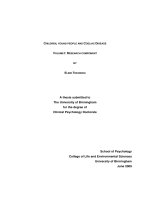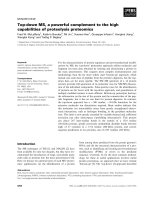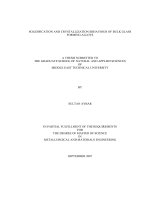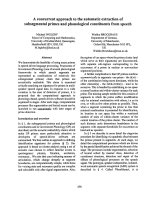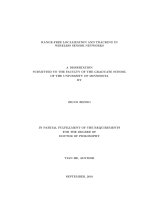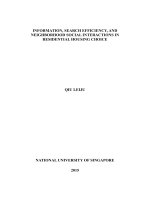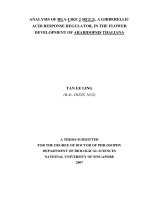LUẬN VĂN " A THESIS SUBMITTED TO THE GRADUATE SCHOOL OF NATURAL AND APPLIED SCIENCES OF MIDDLE EAST TECHNICAL UNIVERSITY " pot
Bạn đang xem bản rút gọn của tài liệu. Xem và tải ngay bản đầy đủ của tài liệu tại đây (2.09 MB, 140 trang )
SOLIDIFICATION AND CRYSTALLIZATION BEHAVIOUR OF BULK GLASS
FORMING ALLOYS
A THESIS SUBMITTED TO
THE GRADUATE SCHOOL OF NATURAL AND APPLIED SCIENCES
OF
MIDDLE EAST TECHNICAL UNIVERSITY
BY
SULTAN AYBAR
IN PARTIAL FULFILLMENT OF THE REQUIREMENTS
FOR
THE DEGREE OF MASTER OF SCIENCE
IN
METALLURGICAL AND MATERIALS ENGINEERING
SEPTEMBER 2007
Approval of the thesis:
SOLIDIFICATION AND CRYSTALLIZATION BEHAVIOUR OF BULK
GLASS FORMING ALLOYS
submitted by Sultan AYBAR in partial fulfillment of the requirements for the
degree of Master of Science in Metallurgical and Materials Engineering
Department, Middle East Technical University by,
Prof. Dr. Canan Özgen
Dean, Graduate School of Natural and Applied Sciences
Prof. Dr. Tayfur Öztürk
Head of Department, Metallurgical and Materials Engineering
Prof. Dr. M. Vedat Akdeniz
Supervisor, Metallurgical and Materials Eng. Dept., METU
Prof. Dr. Amdulla O. Mekhrabov
Co-supervisor, Metallurgical and Materials Eng. Dept., METU
Examining Committee Members:
Prof. Dr. Tayfur Öztürk
Metallurgical and Materials Eng. Dept., METU
Prof. Dr. M. Vedat Akdeniz
Metallurgical and Materials Eng. Dept., METU
Prof. Dr. Amdulla O. Mekhrabov
Metallurgical and Materials Eng. Dept., METU
Prof. Dr. İshak Karakaya
Metallurgical and Materials Eng. Dept., METU
Asst. Prof.Dr. Kâzım TUR
Materials Eng. Dept., Atılım University
Date:
iii
PLAGIARISM
I hereby declare that all information in this document has been obtained and
presented in accordance with academic rules and ethical conduct. I also declare
that, as required by these rules and conduct, I have fully cited and referenced
all material and results that are not original to this work.
Name, Last name: Sultan Aybar
Signature :
iv
ABSTRACT
SOLIDIFICATION AND CRYSTALLIZATION BEHAVIOUR OF
BULK GLASS FORMING ALLOYS
Aybar, Sultan
M.S., Department of Metallurgical and Materials Engineering
Supervisor: Prof. Dr. M. Vedat Akdeniz
Co-Supervisor: Prof. Dr. Amdulla O. Mekhrabov
September 2007, 121 pages
The aim of the study was to investigate the crystallization kinetics and solidification
behaviour of Fe
60
Co
8
Mo
5
Zr
10
W
2
B
15
bulk glass forming alloy. The solidification
behaviour in near-equilibrium and non-equilibrium cooling conditions was studied.
The eutectic and peritectic reactions were found to exist in the solidification
sequence of the alloy. The bulk metallic glass formation was achieved by using two
methods: quenching from the liquid state and quenching from the semi-state.
Scanning electron microscopy, x-ray diffraction and thermal analysis techniques
were utilized in the characterization of the samples produced throughout the study.
The choice of the starting material and the alloy preparation method was found to be
effective in the amorphous phase formation.
The critical cooling rate was calculated as 5.35 K/s by using the so-called
Barandiaran and Colmenero method which was found to be comparable to the best
glass former known to date.
v
The isothermal crystallization kinetics of the alloy was studied at temperatures
chosen in the supercooled liquid region and above the first crystallization
temperature. The activation energies for glass transition and crystallization events
were determined by using different analytical methods such as Kissinger and Ozawa
methods.
The magnetic properties of the alloy in the annealed, amorphous and as-cast states
were characterized by using a vibrating sample magnetometer. The alloy was found
to have soft magnetic properties in all states, however the annealed specimen was
found to have less magnetic energy loss as compared to the others.
Keywords: Bulk Glass Forming Alloy, Thermal Analysis, Supercooled Liquid
Region, Activation Energy, Critical Cooling Rate.
vi
ÖZ
KALIN KESİTLİ, İRİ VE HACİMLİ METALİK CAMLARIN
KATILAŞMA VE KRİSTALLEŞME DAVRANIŞLARI
Aybar, Sultan
Yüksek Lisans, Metalurji ve Malzeme Mühendisliği Bölümü
Tez Yöneticisi: Prof. Dr. M. Vedat Akdeniz
Ortak Tez Yöneticisi: Prof. Dr. Amdulla O. Mekhrabov
Eylül 2007, 121 sayfa
Bu çalışmanın amacı, iri hacimli Fe
60
Co
8
Mo
5
Zr
10
W
2
B
15
alaşımının katılaşma
davranışı ve kristalleşme kinetiğinin incelenmesidir. Katılaşma davranışı, dengeye
yakın ve denge olmayan soğutma koşullarında çalışılmıştır. Alaşımın katılaşma
sürecinde ötektik ve peritektik reaksiyonların olduğu tespit edilmiştir. İri hacimli
metalik cam oluşumu iki yöntemle elde edilmiştir: alaşıma sıvı halden su verme ve
yarı katı halden su verme. Taramalı elektron mikroskobu, x ışınları kırınımı ve
termal analiz teknikleri, çalışma boyunca üretilen numunelerin tanımlanmasında
kullanılmıştır. Hammadde türü seçiminin ve alaşım hazırlama metodunun amorf
fazın görüldüğü kritik kalınlığı etkilediği ortaya çıkmıştır.
Alaşımın, Barandiaran-Colmenero metodu uygulanarak 5.35 K/s olarak tayin edilen
kritik soğuma hızının bilinen en iyi cam oluşturma yeteneğine sahip alaşımınkiyle
kıyaslanabilir olduğu görülmüştür.
vii
Alaşımın izotermal kristalleşme kinetiği; fazla soğutulmuş sıvı bölgesinde ve
kristalleşme sıcaklığının üstünde seçilen sıcaklıklarda çalışılmıştır. Cam dönüşümü
ve kristalleşme aktivasyon enerjileri, Kissinger, Ozawa metotları gibi farklı analitik
metotlar kullanılarak belirlenmiştir.
Alaşımın manyetik özellikleri, tavlanmış, amorf ve ilk döküldüğü haliyle titreşimli
numune magnetometresi kullanarak tanımlanmıştır. Alaşımın bütün hallerde soft
manyetik özelliklere sahip olduğu ancak tavlanan numunenin diğerlerine göre daha
az manyetik enerji kaybının olduğu tespit edilmiştir.
Anahtar Kelimeler: İri Hacimli Metalik Camlar, Termal Analiz, Fazla Soğutulmuş
Sıvı Bölgesi, Aktivasyon enerjisi, Kritik Soğuma Hızı.
DEDICATION
viii
To my beloved parents;
Elif-Celal Aybar
and brothers;
Hakan Aybar, Adnan Yazar
ix
ACKNOWLEDGEMENTS
I express my deepest gratitude to my supervisor Prof. Dr. M. Vedat Akdeniz and co-
supervisor Prof. Dr. Amdulla O. Mekhrabov for their insights, courage, and
optimism. They guided me through a rich research experience. I am very grateful
for their generosity that made possible for me to freely conduct my experiments. I
have learned so much from them.
I am indebted my family for their understanding, love and unfettered belief in me.
They always supported me by cheering me up and make me think positively. It
would not have been possible without their guidance and support.
I would like to send my thanks and love to Burak Beşler for enlightening my days by
being supportive, adoring and keeping me in track even in the bad days.
Since the beginning of my graduate study, I have own a lot to my dear friend Sibel
Mete. I would like to express my thanks for her conversations, ideas, and
encouragement. She has been an informal mentor for me.
I gratefully thank to my dear friends, Gül Fidan Sarıbay and Eda Şeyma Kepenek for
their love and sacrifice for me. Their company made my life easier and colorful.
Special thanks to Cem Topbaşı for his accompany in never-ending laboratory hours,
discussions, kind assistance in the experiments, stimulating critics and original ideas.
I want to thank all my friends from the Novel Alloys Design and Development
Laboratory; Sıla Süer, Muratahan Aykol, Mehmet Yıldırım and Nagehan Duman for
x
their support, friendship, and being much more than labmates. I must also thank to
Başak Karagücük for her good company and motivation.
All my colleagues from the Undersecretariat of the Prime Ministry for Foreign Trade
and Environmental Protection Agency for Special Areas are also gratefully
acknowledged for their support.
xi
TABLE OF CONTENTS
ABSTRACT iv
ÖZ vi
DEDICATION vii
ACKNOWLEDGEMENTS ix
TABLE OF CONTENTS xi
LIST OF TABLES xiv
LIST OF FIGURES xv
CHAPTERS
1.INTRODUCTION 1
2.THEORY 3
2.1HISTORY OF METALLIC GLASSES 3
2.2 BASIC CONCEPTS OF METALLIC GLASSES 8
2.2.1 Conventional Glasses and Glass Transition 8
2.2.2 Glass Formation 12
2.2.2.1 Thermodynamics of glass formation 13
2.2.2.2 Kinetics of glass formation 15
2.3 GLASS-FORMING ABILITY CRITERIA FOR BULK METALLIC
GLASSES 16
2.3.1 Topological Criterion 18
2.3.2 Parameters Involving Characteristic Temperatures 19
2.3.2.1
φ
criterion 22
2.3.2.2 γ criterion 22
2.3.2.3 δ criterion 24
2.3.2.4 α and β criteria 25
2.3.3 The Use of Phase Diagrams in Evaluating the GFA 26
2.3.4 Bulk Glass Forming Ability 27
2.3.5 Theoretical Studies Concerning GFA 28
xii
2.4 PRODUCTION METHODS OF BULK METALLIC GLASSES 28
2.5 CRYSTALLIZATION OF BULK METALLIC GLASSES 30
2.5.1 Phase Separation 32
2.5.2 Structural Relaxation 32
2.5.3 Crystallization Kinetics 33
2.5.3.1 Isothermal crystallization kinetics-JMAK analysis 34
2.5.3.2 Non-isothermal crystallization kinetics: Kissenger
and Ozawa Methods 36
2.5.4 Methods Used in Critical Cooling Rate Calculations 39
2.5.4.1 Quantitative evaluation of critical cooling rate 39
2.5.4.2 Measuring the critical cooling rate by analyzing
crystallization peaks from continuously cooled
melts 40
2.5.5 Nanocrystallization of Bulk Metallic Glasses 43
2.6 PROPERTIES AND APPLICATIONS OF BULK METALLIC
GLASSES 45
2.6.1 Mechanical Properties 46
2.6.2 Magnetic Properties 47
2.6.3 Chemical Properties 48
2.6.4 Applications 48
3.EXPERIMENTAL PROCEDURE 50
3.1 ALLOY PREPARATION 50
3.1.1 Raw Materials 50
3.1.2 Alloy Preparation Methods 50
3.2 BULK METALLIC GLASS FORMATION 54
3.2.1 Quenching from the Liquid State 54
3.2.2 Quenching from the Semi-Solid State 57
3.3 EQUILIBRIUM SOLIDIFICATION OF THE MASTER ALLOY 58
3.4 SAMPLE CHARACTERIZATION 58
3.4 CRYSTALLIZATION EXPERIMENTS 61
4. RESULTS AND DISCUSSIONS 63
xiii
4.1 THE SOLIDIFICATION BEHAVIOR OF Fe
60
Co
8
Mo
5
Zr
10
W
2
B
15
ALLOY 63
4.2 BULK METALLIC GLASS FORMATION 72
4.2.1 Quenching from the Liquid State 73
4.2.2 Quenching from the Semi-solid State 84
4.3 EXPERIMENTAL ESTIMATION OF CRITICAL COOLING RATE88
4.4 CRYSTALLIZATION KINETICS 93
4.8 MAGNETIC PROPERTIES OF THE ALLOY 105
5. CONCLUSIONS 107
REFERENCES 110
APPENDIX A 120
xiv
LIST OF TABLES
Table page
Table 2.1 The bulk glass forming alloy systems produced between the years 1988-
2002 (reproduced after Ref. [25]). 7
Table 3.1 Composition of the FeB alloy in weight percent 51
Table 3.2 Composition of alumina used in crucible production 52
Table 4.1 DSC data of the as-prepared and annealed samples 69
Table 4.2 DSC data of the cylindrical sample. 72
Table 4.3 DSC data of the bulk amorphous samples together with the caculated T
rg
,
∆T
x
and γ parameters. 1
Table 4.4 DSC data of the sample quenched from the semi-solid state and the
estimated fraction of amorphous phase 86
Table 4.5 Comparison of reaction enthalpies estimated during the first and second
heating scans 92
Table 4.6 Activation energies estimated by using Kissinger method 103
Table 4.7 Activation energies estimated by using Ozawa method 105
xv
LIST OF FIGURES
Figure page
Figure 2.1 The critical casting thickness for the glass formation as a function of the
year the corresponding alloy has been discovered [23]. 5
Figure 2.2 Schematic TTT diagram for crystal growth in an undercooled melt,
showing (1) rapid cooling to form a glass, (2) isothermal heat treatment
of the glass leading to crystallization at time t
x
, (3) slow heating of the
glass giving crystallization at T
x
[reproduced after Ref. [3]) 8
Figure 2.3 Variation of properties of crystalline and non-crystalline materials with
temperature (reproduced after Ref. [27]). 10
Figure 2.4 (a) Specific heat as a function of temperature, (b) DSC curve for
Cu
55
Hf
25
Ti
15
Pd
5
alloy, (c) the ration of X-ray diffraction peak positions
Q
0
/Q
T
related to L
T
/L
0
vs. temperature, and (d) DSC curve and Arrhenius
plot created using incubation time for phase transformation in
Al
85
Ni
5
Y
4
Nd
4
Co
2
alloy. (After Ref. [29]) 11
Figure 2.5 (a) Schematic representation of the atomic location in a liquid within the
glass transition region, the glassy areas shown with dashed lines, (b) and
(c) indications of a process of solidification [30] 12
Figure 2.6 The entropy difference between the crystal and liquid states for pure
metals and bulk metallic glass forming alloys after Ref. [37]. 14
Figure 2.7 A comparison of viscosity of various glass-forming liquids. The plot
shows that the BMG forming liquid can be classified as strong liquid 16
Figure 2.8 A typical DSC curve for an amorphous alloy on heating [48]. 19
Figure 2.9 Correlation between the critical cooling rate and the γ parameter for
typical metallic glasses [55] 23
Figure 2.10 Schematic illustration of a copper mould casting equipment, (a) in a ring
shape form [65], (b) in a wedge shape form [66] 29
xvi
Figure 2.11 Schematic representation of the enthalpy relaxation signal. The
continuous line is the signal for glassy state, whereas the dashed line is
the schematic baseline of the crystalline sample subjected to the same
anneal. The glass first relaxed into the supercooled liquid (relaxed) state
and crystallized with further isothermal annealing. The regions marked as
A-D indicate: (A) the heating of the sample with constant heating rate up
to a selected temperature; (B) the exothermic heat release due to the
relaxation at the beginning of the isothermal annealing at this
temperature; (C) the supercooled liquid or relaxed state, (D) the
crystallization event. (Adapted from [69]) 34
Figure 2.12 JMAK plot of ln[−ln(1 − x)] against ln(t) for Cu
43
Zr
43
Al
7
Ag
7
alloy
showing a characteristic straight line with a slope n. Adapted from [78].
36
Figure 2.13 (a) Continuous heating DSC curves of Zr
55
Cu
30
Al
10
Ni
5
bulk amorphous
alloys at different heating rates, (b) Kissenger plots of the glass transition
and crystallization from which the activation energies for glass transition
and crystallization are obtained [84] 38
Figure 2.14 Schematic of a typical temperature-time cooling curves for a
hypothetical melt when cooled at different rates, R. The melt crystallizes
when cooled from T
m
at rate less than the R
c
crystallization is indicated
by an exothermic peak. The onset temperature for crystallization, T
c
, and
the height of the peak, h, decrease with increasing R, and the R for which
the crystallization peak just disappears is the R
c
. The inset shows a
continuous-cooling-temperature diagram based on the temperature-time-
cooling curves [87] 42
Figure 2.15 Elastic limit σ
y
and Young’s Modulus E for over 1507 metals, alloys and
metal-matrix composites and metallic glasses. The contours show the
yield strain σ
y
/E and the resilience E
y
/
2
σ
[102]. 47
Figure 3.1 (a) Polyamide moulds used in alumina crucible production. (b) Two
crucibles with the one on the left hand side was prepared by the
xvii
polyamide mould free of surface cracks and the one on the right hand
side produced by conventional technique containing cracks. 53
Figure 3.2 Heat treatment procedure applied to alumina crucibles. 53
Figure 3.3 Technical drawings of the moulds. (a) Mould1, (b) inner wedge shape of
mould1, (c) mould 2, (d) inner wedge shape of mould2, (e) mould 3, (f)
inner cylindrical shape of mould 3 56
Figure 3.4 The experimental set-up used in quenching experiments 57
Figure 3.5 Heating and cooling sequence applied in some DSC experiments. For
each couple of cycles, sample in the DSC crucible was changed 61
Figure 4.1 The secondary electron (SE) images of the alloy annealed at 1000 ºC for
1 hour in the furnace magnified (a) 1000 times and (b) 3000 times to its
actual size 64
Figure 4.2 The schematic drawing of the master ingot slice showing examined
regions indicated by numbers. 64
Figure 4.3 Secondary electron images of (a) bottom edge (region1), (b) the middle
section (region 2), and (c) top section (region3) of the master alloy ingot.
The eutectic structure starts to appear as the cooling rate is decreased. . 66
Figure 4.4 The XRD patterns of the master alloy ingot at annealed and as-prepared
states.The spectra are shifted for clarity 67
Figure 4.5 DSC heating curve for the master alloy ingot in the as-prepared and
annealed states obtained at a scan rate of 20 ºC/min. 68
Figure 4.6 Schematic drawing of the cylindrical sample and its analyzed cross
section 69
Figure 4.7 The SE images of the (a) outer and (b) inner regions of the cylindrical
sample magnified 1000 times to the actual sizes. 70
Figure 4.8 The SE images of the (a) outer and (b) inner regions of the cylindrical
sample magnified 1000 times to the actual sizes. 71
Figure 4.9 The DSC trace of cylindrical sample scanned at a rate of 20 ºC/min 72
Figure 4.10 XRD patterns of the thin part having a diffuse halo peak and thick part
exhibiting some crystalline peaks. 74
xviii
Figure 4.11 (a) Secondary electron image of thin part showing a featureless matrix,
(b) back scattered electron image of thick part of the sample produced b
using FeB master alloy and induction heating method. 74
Figure 4.12 DSC trace of the sample prepared by using FeB master alloy and
induction heating method scanned at a rate of 20 ºC/min showing glass
transition, crystallization and invariant reactions on heating 75
Figure 4.13 Schematic drawing of the wedge shaped sample. Dashed lines show the
axes used in sectioning 76
Figure 4.14 XRD patterns of wedge shaped sections a, b, and c indicated by the
corresponding thicknesses 77
Figure 4.15 Secondary electron images of (a) sections (a) showing a featureless
image, (b) section (b) with α-Fe trying to grow in the amorphous matrix,
and (c) section (c). Dendritic features of α-Fe were observed to increase
in size. 78
Figure 4.16 DSC pattern of amorphous section of the sample prepared by using FeB
master alloy and arc melting method. Glass transition and crystallization
reactions can be observed. Scanning rate was 20 ºC/min. 79
Figure 4.17 XRD patterns of the different section of the sample prepared by using
pure constituents and arc melting method 80
Figure 4.18 DSC pattern of amorphous section of the sample prepared by using pure
constituents and arc melting method. Glass transition and crystallization
reactions can be observed. Scanning rate was 20 ºC/min. 81
Figure 4.19 Phase diagram and schematic melting DSC curve of a hypothetical
binary alloy which melts through a sequence of eutectic and peritectic
reactions [6] 84
Figure 4.20 DSC trace of the sample quenched from the semi-solid state. 86
Figure 4.21. SE images of the quenched sample magnified (a) 1000 times, (b) 3000
times to its actual size. 88
Figure 4.22 DSC cooling curves of Fe
60
Co
8
Zr
10
Mo
5
W
2
B
15
amorphous alloy at
various cooling rates. 89
Figure 4.23 The critical cooling rate plot of ln R versus 10000/∆T
xc
2
. 89
xix
Figure 4.24 The critical cooling rate plot of ln R versus 10000/∆T
xc
2
for the eutectic
reaction 90
Figure 4.25 First and second heating scans at a rate of 20 ºC/min. The spectra have
been shifted for clarity. 92
Figure 4.26 The DSC trace of the amorphous sample isothermally heated at 650 and
750 ºC for 5 hours in the furnace. Scanning rate was 20 ºC/min 94
Figure 4.27 The SEM micrograph of the amorphous sample annealed at 650 ºC for 5
hours in the furnace 95
Figure 4.28 XRD patterns of amorphous samples annealed at 650 and 750 ºC for 5
hours in the furnace showing a diffuse background with weak α-Fe
peaks 96
Figure 4.29 The SEM micrographs of the amorphous sample isothermally heated at
750 ºC. (a) SE image of the thinnest part of the specimen, (b) magnified
10000 times, (c) SE image of the thick part, (d) closer view of (c), and (e)
BSE image of a small region in (b) magnified 11000 times 97
Figure 4.30 Isothermal DSC scans of the amorphous samples at 650 and 750 ºC for 5
hours. The dashed line shows the second scan performed for the
identification of the peak appearing at around 1100 seconds. 98
Figure 4.31 Isothermal DSC scan of the master alloy ingot piece at 650 for 5 hours
99
Figure 4.32 The continuous heating curves at scanning rates of 5 to 99 ºC/min 100
Figure 4.33 Dependence of transition temperatures on the scanning rate determined
from the DSC experiment. 102
Figure 4.34 Kissinger plots for the glass transition and three exothermic reactions by
using DSC data of 5, 10, and 20 °C/min 103
Figure 4.35 Ozawa plots of ln β as a function of 1000/T for glass transition and
exothermic transitions excluding the DSC data of 40 and 99 °C/min. . 105
Figure 4.36 Hysteresis loops of the as-cast, annealed and amorphous samples 106
Figure A.1 Binary phase diagram of B-Zr. 120
Figure A.2 Binary phase diagram of Fe-Zr 121
1
CHAPTER 1
INTRODUCTION
Bulk metallic glasses have an unusual combination of physical, mechanical,
magnetic, and chemical properties because of their random, non-crystalline atomic
arrangements making them superior to their crystalline counterparts [1]. They are
produced by using different techniques all of which involve the rapid solidification.
They display high strength, low Young’s modulus and excellent corrosion resistance
[2].
The atoms are frozen in their liquid configuration as a result of rapid solidification
[3]. Metallic glasses are non-equilibrium structures with respect to the crystalline
state. For this reason, they go through structural changes from the as cast state to the
metastable structurally relaxed state and finally to the crystalline state when
moderately heated. Physical, chemical, and mechanical properties of the metallic
glasses are significantly affected by the structural changes that occur during heating
at temperature low enough to avoid crystallization [4, 5]. Therefore, the study of
crystallization behaviour of metallic glasses is very important in the sense that the
crystallization parameters of an amorphous phase reflect how stable it is against the
thermal treatments that may present in the practical applications.
The aim of this study in general was to investigate the solidification and
crystallization behaviour of Fe
60
Co
8
Mo
5
Zr
10
W
2
B
15
bulk glass forming alloy system.
This alloy was chosen since it was confirmed to have a high glass forming ability by
the previous studies [6, 7]. The ternary Fe-Zr-B alloys were studied by Pehlivanoğlu
[7] by adding minor alloying elements systematically and the Mo and W elements
were found to increase the glass forming ability. The theoretical studies using the
2
simulation models also showed that the alloy was a good glass former. However, the
crystallization kinetics of the alloy has not been studied in detail so far. Therefore,
this study aims at investigating the crystallization kinetics by means of the
experimental and analytical methods.
In addition, for the first time in this study, amorphous phase formation was
attempted to be obtained by quenching the alloy from the semi-solid state. The
existence of the semi-solid region between the eutectic and peritectic temperatures in
Fe
60
Co
8
Zr
10
Mo
5
W
2
B
15
was considered to be utilized for obtaining amorphous phase
without complete melting of the alloy. The ability to process the bulk amorphous
alloys in the semi-solid region is expected to open new perspectives to the study of
bulk metallic glass formation.
The literature review on the subject and some basic concepts of the glass formation
is given in Chapter Two. The analytical methods employed in the experimental
studies are explained in this chapter. In the next chapter, the experimental methods
used and the experiments carried out are presented. In Chapter Four, the results of
the experiments are given together with the simultaneous discussion. The
conclusions drawn are given in the Fifth Chapter.
3
CHAPTER 2
THEORY
2.1HISTORY OF METALLIC GLASSES
The first amorphous metallic alloys were claimed to have been made by Kramer [8]
using vapor deposition. Then, it was proposed by Brenner et al. [9] that amorphous
nickel-phosphorus alloys had been produced via electrodepositing.
Metallic amorphous alloys are comparatively new in the amorphous materials group.
The first metallic glass was Au
75
Si
25
reported by Duwez [10] at Caltech, USA, in
1960. They showed that the nucleation and growth of crystalline phase could be
kinetically bypassed in some liquefied alloys to produce a frozen liquid
configuration called the metallic glass. The cooling rate used to obtain this structure
was on the order of 10
6
K/s which put a restriction in the specimen geometry. Only
thin ribbons, foils and powders were produced with at least one dimension is small
enough, on the order of microns, to allow such a high cooling rate [11].
The fundamental scientific significance and potential engineering applications of
bulk metallic glasses have increased the attention to studies on their formation,
structure and properties [12]. The work of Turnbull group found similarities between
metallic glasses and other non-metallic glasses such as silicates, ceramic glasses and
polymers. They pointed out that glass transition seen in conventional glass-forming
melts could also be observed in metallic glasses produced by rapid quenching [13-
15].
4
Turnbull predicted that a ratio, called reduced glass transition temperature
T
rg
=T
g
/T
m
, of the glass transition temperature T
g
to the melting point or liquidus
temperature T
m
of alloy could be used as a criterion for determining the glass
forming ability of (GFA) of an alloy [16]. Accordingly, a liquid with T
rg
=2/3
becomes very sluggish in crystallization and its crystallization temperature range is
very narrow. This criterion for the suppression of crystallization in undercooled
melts is used as a rule of thumb for predicting the GFA of any liquid [17].
If the millimeter scale is termed as “bulk”, the first bulk metallic glass was the
ternary Pd-Cu-Si alloy prepared by Chen in 1974 by using simple suction casting
method to form millimeter-diameter rods of Pd-Cu-Si metallic glass at a
significantly lower cooling rate of 10
3
K/s [18].
In the beginning of the 1980’s, the Turnbull group were able to reduce the amount of
heterogeneous nucleation sites and thus able to make glassy ingots of Pd
40
Ni
40
P
20
with a diameter of 5 mm by subjecting the specimens to surface etching followed by
a succession of heating and cooling cycles. Then in 1984, they could obtain a critical
casting thickness of 1 cm by processing the Pd-Ni-P melt in a boron oxide flux [19].
The Inoue group in Japan studied on rare-earth materials with Al and ferrous metals
during the late 1980s. They produced fully glassy cylindrical samples with diameters
of up to 5 mm or sheets by casting La
55
Al
25
Ni
20
(or later La
55
Al
25
Ni
10
Cu
10
up to 9
mm) into Cu moulds [20]. Mg-Cu-Y and Mg-Ni-Y alloys with the largest glass
forming ability obtained in Mg
65
Cu
25
Y
10
were developed by the same group in 1991
[21].
The Inoue group also produced a family of Zr-based Zr-Al-Ni-Cu alloys having a
high glass forming ability and thermal stability [22]. The critical casting thickness
up to 15 mm was obtained in these alloys and the supercooled liquid region was
extended to 127 K for the alloy Zr
65
Al
7.5
Ni
10
Cu
17.5
. The production of these alloys
showed that the bulk metallic glass compositions were not a laboratory curiosity and
could be studied for engineering applications [23].
5
After the significant effects of Inoue’s works were realized, Johnson and others from
Caltech started to work on bulk metallic glass compositions in the early 1990s. In
1993, Zr
41.2
Ti
13.8
Cu
12.5
Ni
10
Be
22.5
[=(Zr
3
Ti)
55
(Be
9
Cu
5
Ni
4
)
45
], commonly referred to as
Vitreloy 1 (Vit1), with a critical thickness of several centimetres was produced by
Peker and Johnson [24]. This and the Inoue’s work [25] can be considered as the
starting point for the use of bulk glassy materials in structural applications. The Vit1
alloy has been investigated extensively in the next ten years [23]. The Inoue group in
1997 restudied Pd
40
Ni
40
P
20
alloy and replaced 30% Ni by Cu to produce an alloy
with a critical casting thickness of 72 mm [25]. Figure 2.1 shows the critical casting
thickness for glass formation versus the year of discovery of the corresponding
alloy.
Figure 2.1 The critical casting thickness for the glass formation as a function of the
year the corresponding alloy has been discovered [23].
The critical casting thickness increased by more than three orders of magnitude in
the last 40 years [23]. The future applications of the bulk metallic glasses can be
6
predicted using this increasing trend. The bulk glass forming alloy systems which
are produced until year 2002 are given in Table 2.1 which classifies the alloy
systems as non-ferrous and ferrous [25] .
Recently, the researches on the bulk metallic glasses are growing significantly.
Many researchers are studying on the new alloy compositions and investigating the
mechanical, structural, thermophysical, and magnetic properties of these alloys.
Based on the recent developments, new applications of the bulk metallic glasses can
be expected in the near future [3].
